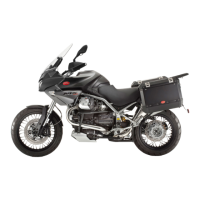
Do you have a question about the MOTO GUZZI Stelvio 1200 NTX 2012 and is the answer not in the manual?
| Displacement | 1151 cc |
|---|---|
| Bore x Stroke | 95 x 81.2 mm |
| Fuel System | Electronic fuel injection |
| Ignition | Digital electronic |
| Transmission | 6-speed |
| Final Drive | Shaft |
| Front Tire | 110/80 R19 |
| Rear Tire | 150/70 R17 |
| Wheelbase | 1535 mm |
| Seat Height | 840 mm |
| Engine Type | V-twin, 4-stroke |
| Maximum Power | 105 hp (77 kW) at 7, 250 rpm |
| Maximum Torque | 113 Nm (83 lb-ft) @ 5800 rpm |
| Frame | Tubular steel |
| Front Suspension | 45 mm telescopic forks |
| Rear Suspension | Swingarm with adjustable shock |
| Front Brakes | Dual 320 mm discs |
| Rear Brakes | 282 mm disc |
| Brakes | ABS |
Essential safety guidelines before operating the motorcycle.
Introduction to the use and maintenance booklet.
Risks associated with carbon monoxide from exhaust fumes and necessary precautions.
Guidelines for safe handling, storage, and disposal of gasoline, covering toxicity and flammability.
Alerts regarding hot engine, exhaust, and brake system components.
Guidance on starting the motorcycle and initial riding phases, including braking.
Explanation of dashboard warning lights and their meanings.
Proper disposal and handling of used oils.
Precautions and hazards associated with brake and clutch fluid.
Safety warnings regarding battery electrolyte, gases, and handling.
Proper use and safety precautions for side and center stands.
Important overarching safety advice and information sources.
Procedure for reporting vehicle defects that could compromise safety.
Adherence to road rules and guidelines for proper motorcycle operation.
Information on the exhaust system's compliance with noise emission standards.
Explanation of emissions produced during combustion.
Prohibitions and consequences of tampering with exhaust and emissions control systems.
Symptoms indicating potential problems affecting motorcycle emissions.
Diagram showing the location of various warning labels on the motorcycle.
Details on various warning labels concerning vehicle operation, safety, and emissions.
Diagram and explanation of the California evaporative emission control system.
Details on warranty periods for emission control system components by vehicle class.
Owner's duties for maintenance and reporting to ensure warranty validity.
Description of covered emission control system components and warranty repairs.
Exclusions and limitations applicable to the emission control system warranty.
Definition of the manufacturer's limited liability concerning the warranty.
Overview of major motorcycle components and their locations.
Identification and operation of dashboard instruments and controls.
Function and operation of the ignition switch, steering lock, and handlebar controls.
Operation of hazard lights, starter, engine stop, ABS, and ATC systems.
Use of power sockets, saddle access, vehicle identification, and accessory preparation.
Essential checks before riding to ensure safety and proper operation.
Safe practices for refueling, covering fuel hazards and fire prevention.
Procedure for adjusting rear shock absorbers and front fork settings.
Instructions for adjusting front brake and clutch levers.
Importance and guidelines for the initial break-in period of the motorcycle.
Guidance on dealing with difficult starting, proper parking, and catalytic silencer safety.
Recommendations for preventing theft and essential riding safety rules.
Guidelines for securing luggage and maintaining vehicle balance.
Importance of protective clothing and reflective elements for rider visibility.
Procedures for checking engine oil level, topping off, and changing oil.
Checking and servicing universal joint and gearbox oil levels.
Guidelines for checking tire pressure, wear, and condition.
Procedure for spark plug removal, inspection, and replacement.
Checking and topping up brake and clutch fluid levels.
Instructions for installing a new battery, charging, and long-term storage.
Procedure for checking and replacing fuses, including safety warnings.
Guidelines for maintaining motorcycle lights, including bulb replacement.
Precautions and maintenance for disc brakes, including pad wear and wheel removal.
Steps for preparing the motorcycle for storage and guidelines for cleaning.
Specifications for motorcycle dimensions, weight, and engine details.
Information on fuel system, fluid capacities, and electrical components.
Specifications for chassis, brake system, and transmission components.
Details on wheel sizes, rim types, and tire specifications.
Information on tire usage, speed limits, and road condition considerations.
List of tools provided with the motorcycle.
Explanation of scheduled maintenance importance and reporting anomalies.
Comprehensive chart detailing maintenance tasks and recommended intervals.
List of recommended oils, greases, and fluids for vehicle maintenance.
Information on available accessories and clothing; contact dealer for details.
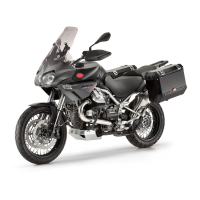

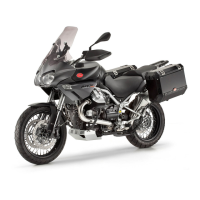
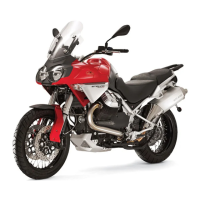
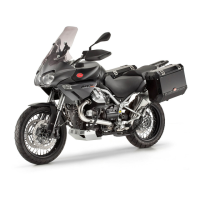
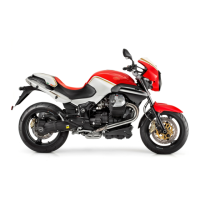

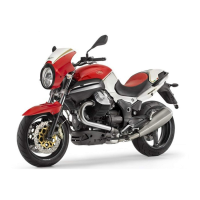
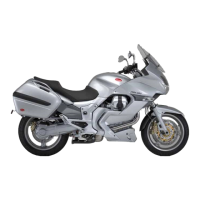
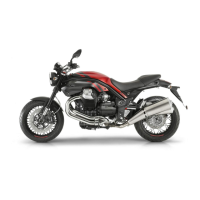
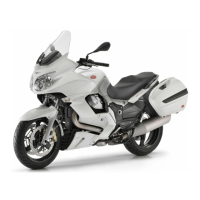
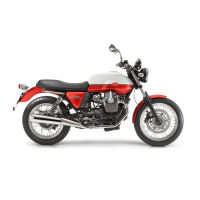
